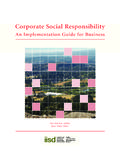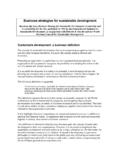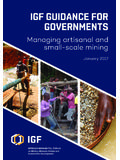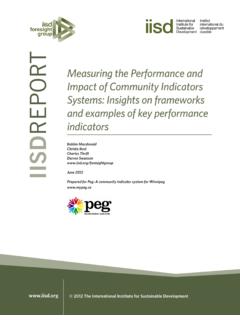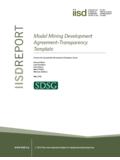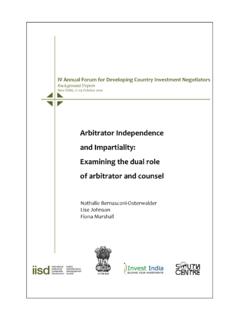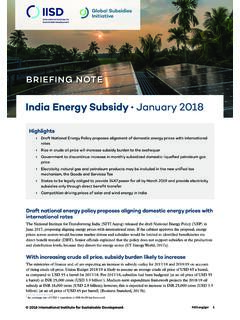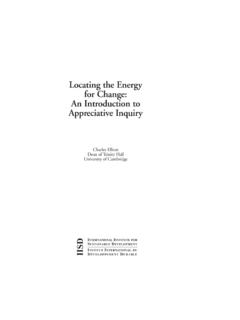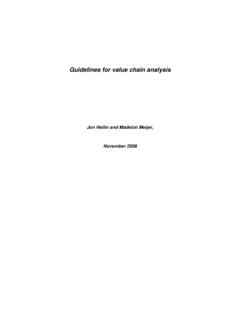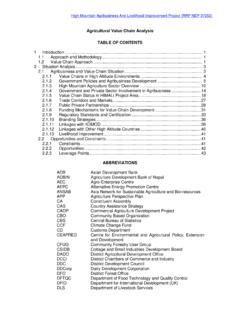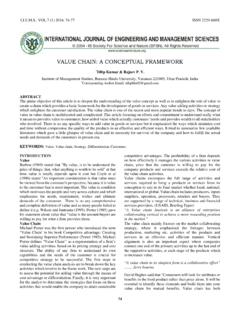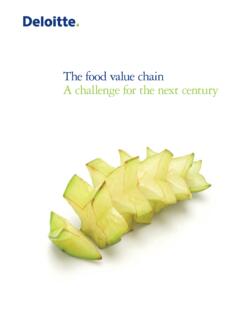Transcription of Global Market Report: Sugar - International Institute for ...
1 Sugarcane demand will grow for food and fuel production, driven by increased Sugar consumption in Asia and is a crop primarily grown in tropical countries and has the notable quality of serving as both a food and a fuel source. Along with supplying 86 per cent of the world s Sugar (the remaining coming from beet), sugarcane also serves as a key biofuel feedstock, given that it is highly efficient in converting sunlight into ,10 Seventy-five per cent of the sugarcane produced globally is consumed by the food manufacturing sector; the balance is used in biofuel ,23 Sugarcane cultivation and processing currently provide livelihoods for 100 million people across the Looking at the country level, the sugarcane industry employs over 1 million people in Brazil, nearly 25 per cent of its rural workforce. The Thai sugarcane supply chain employs million people, including 107,000 smallholders, and around million people depend on the sugarcane industry for their livelihoods in South 6,53 Cane Sugar , the raw Sugar obtained from processing sugarcane, had an export value of USD billion in 2017; an estimated per cent (at least 54,593 million tonnes) of total cane Sugar produced that year was ,10 The largest cane Sugar exporting countries in 2017 were Brazil (USD billion), Thailand (USD billion) and France (USD billion); the largest cane Sugar importing countries Global Market Report: SugarSUSTAINABLE COMMODITIES MARKETPLACE SERIES 2019 Vivek Voora, Steffany Berm dez, Cristina Larrea Series Editor: Sofia Bali oVSS-compliant sugarcane accounted for at least per cent of total sugarcane production in 1.
2 Global Sugar production trend 2008 201616,39 Note: VSS-compliant production volumes refer to sugarcane produced in compliance with one or more VSSs. Conventional production volumes do not comply with or are not recognized by an existing VSS. Production volumes that are defined as potentially VSS-compliant cannot be definitively listed in either category with the data currently CompliantPotentiallyVSS CompliantConventional1,600,000,0001,650, 000,0001,700,000,0001,750,000,0001,800,0 00,0001,850,000,0001,900,000,0001,950,00 0,00020082009201020112012201320142015201 6 Metric Tonneswere Indonesia (USD billion), the United States (USD billion) and Bangladesh (USD billion).8,9 Cane Sugar supply growth outpaced demand growth for human consumption from 2016 to 2017, at rates of 8 per cent versus an estimated 2 per cent respectively. This imbalance resulted in a Global cane Sugar surplus of around 11 million Assuming favourable weather conditions, this cane Sugar surplus is expected to persist, according to projections through the year 2025, due to the expansion of planted areas in Asia, specifically China and Indonesia, as well as improved farm ,11 Developing countries account for approximately three-quarters of Global Sugar consumption.
3 They are expected to lead the future demand growth of the sector with increasing consumption of caloric sweeteners, processed products, Sugar -rich confectionery and soft ,14 For example, in 2018, Sugar (white or refined) met almost 80 per cent of the sweetener Market demands, which had a retail value of USD Asia leads in terms of demand growth, followed by Africa,13 mainly due to population growth and urbanization, rising incomes and shifting dietary In contrast, demand is expected to stagnate in developed countries due to slowing population growth; dietary changes; health concerns related to Sugar consumption, such as obesity and diabetes; and government interventions to reduce Sugar ,15 Another notable Market development in the sector is the recent expansion though still very modest of voluntary sustainability standards (VSSs) among sugarcane farms and VSSs were almost non-existent about a decade ago: in 2016, for example, per cent of the Market was made up of VSS-compliant sugarcane, per cent of sugarcane that was potentially VSS-compliant and per cent of conventional sugarcane The growing health concerns related to Sugar consumption have led to increased government regulation, reduced corporate procurement and adjusted consumer preferences for less Sugar intake.
4 These developments have, in turn, slowed down sector Market growth ,17,18 As a result, the Organisation for Economic Co-operation and Development (OECD) and the Food and Agriculture Organization of the United Nations (FAO) predict that sugarcane production will grow at a measured pace of per cent annually from 2018 to 2027, compared to per cent annually over the last In parallel, Sugar consumption will grow at a rate of per cent per annum and is expected to reach a retail Market value of USD billion in ,13 Despite this moderate growth forecast, the sugarcane sector faces important challenges that affect both its overall economic prospects and its sustainability. World Sugar prices (raw and white Sugar ) have historically been highly volatile, and often the price of raw Sugar falls below production costs, making sugarcane farmers vulnerable to falling into debt and losing their land and Government interventions, specifically subsidies and import tariffs, influence Sugar prices greatly.
5 They are also affected by oil price movements, which, in turn, have an impact on ethanol prices and, thus, Sugar prices. Other factors include shifting weather patterns, production methods that have moved toward How much sugarcane is certified by each standard?Figure 2. VSS-compliant sugarcane production volumes in 201616 Bonsucro 51,090,000 MT Fairtrade International 7,015,212 MT Organic 4,875,050 MTA The United Nations Forum on Sustainability Standards (UNFSSs) defines VSSs as standards specifying requirements that producers, traders, manufacturers, retailers or service providers may be asked to meet, relating to a wide range of sustainability metrics, including respect for basic human rights, worker health and safety, the environmental impacts of production, community relations, land use planning and others. To review the purpose of various VSSs and the set of requirements producers need to comply with under each scheme, please access State of Sustainability Initiatives Reviews in the following link: mechanization, and export fluctuations from Brazil and India due to their large domestic ,19,20 Along with price volatility and low farm prices, the sector faces other important challenges.
6 Incidences of significant land acquisition, or land grabbing, have been documented in the Brazilian states of Mato Grosso do Sul and Pernambuco, as well as in Sierra Leone, Indonesia, Kenya, Zambia, Mali and ,21 Furthermore, the industry has a poor labour rights record and documented occurrences of forced and child labour; in addition, occupational health and safety issues at plantations and mills are not uncommon, even in some of the largest producing countries, such as Brazil, India and ,23 Sugarcane cultivation can also have harmful environmental impacts, such as air pollution and greenhouse gas (GHG) emissions that result from sugarcane field burning before manual harvesting. It can also contribute to water stress due to overconsumption and agricultural runoff. Approximately 30 per cent of sugarcane production takes place in high or extremely high water stress areas, and agricultural runoff coupled with the overapplication of fertilizers and pesticides have polluted water ,23 Left unchecked, all of these sustainability challenges could eventually affect continued supply and demand.
7 VSS-compliant sugarcane production is rapidly at least the 1990s, non-governmental organizations, private sector actors and other sugarcane industry stakeholders have used VSSs to provide consumers with a product that they can identify as having been produced through sustainability-conscious methods that address the challenges listed above. For example, sugarcane production that meets these standards needs to limit air pollution and GHG emissions, while also conserving water resources. Compliance also means respecting labour rights and worker health and safety, not engaging in land grabbing and taking steps to improve producer sustainability impacts and reputational risks associated with the sugarcane industry have been a significant motivation for civil society and private sector stakeholders to support the establishment and propagation of VSS in the sector. By providing sugarcane-based product consumers with some assurances that their choices can support more sustainable sugarcane farming practices, VSSs are creating a virtuous cycle of increasing investment in sugarcane farming operations that addresses many of the sector s socio-environmental challenges.
8 VSSs only recently started capturing a share of sugarcane production in 2013 with the establishment a few years earlier of Bonsucro, a single-sector initiative focused on enabling more sustainable sugarcane production. There have been promising signs on the supply side in recent years: VSS-compliant sugarcane experienced a compound annual growth rate (CAGR) of about 52 per cent from 2008 to 2016, reaching at least per cent of sugarcane overall production in 2016. Bonsucro, Fairtrade, Organic and Rainforest Alliance are the main VSSs in the sugarcane sector when ranked by production size. In 2016, at least 60 million tonnes of sugarcane was VSS-compliant, valued at USD billion. This value is derived from the average producer prices per country, as reported by the FAO, which is then applied to the volume of VSS-compliant sugarcane produced per ,24 The majority of VSS-compliant production, LIVELIHOODS100 million people make their living from sugarcane cultivation and processing 25% of the rural workforce in Brazil million people in Thailand million in South AfricaMARKET VALUEOver USD billion worth of VSS-compliant sugarcane based on 2016 sugarcane producer prices CAGR 2008 2016 Conventional production is up by while VSS-compliant production is up by PRODUCTION IN LHDCs2% of total sugarcane produced2% of VSS-compliant sugarcane produced based on 2016 dataat approximately 90 per cent, comes from Latin America, specifically Brazil, Paraguay, Costa Rica and Argentina.
9 Some substantial volumes also come from Australia, India and ,25 Corporate sustainable sourcing commitments are driving demand for VSS-compliant Sugar . The six largest cane Sugar -consuming companies in the food manufacturing sector purchased more than million tonnes in 2017. From this total, at least million tonnes was VSS-compliant. Based on their sourcing commitments and assessing these against current cane Sugar sourcing information, an additional million tonnes of sustainable cane Sugar could be consumed by 2020. These buyer sourcing patterns respond to end-consumer preferences to purchase more sustainably sourced Sugar in certain markets. For instance, evidence suggests that the consumption of organic and Fairtrade Sugar is increasing in In addition, Global demand for organic Sugar has increased in the last few years and is expected to grow at a CAGR of per cent by 2022, fuelled by increased use of organic Sugar in food manufacturing, such as chocolate, confectionery and bakery ,28,54 Despite projected growth in demand for VSS-compliant sugarcane, VSS-compliant sales have not kept up with Demand for sustainably produced Sugar is still new and overall has not been matched by consumer willingness to pay higher In addition, most consumers do not know where the Sugar used in company products comes from, since there is a lack of product traceability through the value chain that makes Sugar the least observed agricultural This is partly influenced by negative health perceptions associated with Sugar .
10 Which disincentivize companies to Market VSS-compliant Sugar content in their products. This supply demand imbalance can pose significant limitations on VSS-compliant sugarcane s Market Good progress toward sourcing more sustainable cane 39,55,56 Figure 3. Major cane Sugar -consuming companies and their sustainable sourcing commitments**Source: See details of the estimates at the end of this document. Sustainable Consumption (MT, 2017)Conventional Consumption (MT, 2017)Sustainable Sourcing Commitment (% and year)01,000,0002,000,0003,000,0004,000,0 005,000,000** Nestl Metric TonnesUnileverKelloggPepsico IncCoca-Cola* Associated British Foods * data not found for sustainable sourcing commitments** data estimated refers to Sugar (it can include cane Sugar and beet Sugar )Commitment to 100% sustainable sourcing by 20205,000,000 MT25% Sustainable Consumption in 201775% Conventional Consumption in 2017In 2017, Coca-Cola's estimated total cane Sugar consumption was 5,000,000 metric tonnes, of which an estimated 25% was sustainably sourced.
